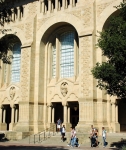The Archive of Recorded Sound has completed the processing of four significant collections under the sponsorship of the Council on Library and Information Resources (CLIR) with funding from the Andrew W. Mellon Foundation which are now ready for use by researchers, students, musicians, and the public. The creators of all four collections have California connections, but their work and influence extended far beyond state borders to distant regions of the world. The four collections that have been organized, arranged, and described in finding aids, which can be viewed on the Online Archive of California, are the Yehudi Menuhin, the Jascha Heifetz, the Lawrence Tibbett, and the Ambassador Auditorium Collections. The processing archivist for the project was Frank Ferko, with assistance from Anna Graves.
Located in the City of Pasadena, the Ambassador Auditorium hosted many of the most highly regarded concert musicians and popular entertainers in the world. From its opening night on April 7, 1974 to its closing in May, 1995, the Ambassador, often called "the Carnegie Hall of the West", presented a veritable who's who of luminaries in the world of music, dance, and popular entertainment. Among those who performed there were Artur Rubinstein, Leontyne Price, Victor Borge, Andres Segovia, Barbara Cook, the Juilliard String Quartet, the Los Angeles Chamber Orchestra, Yo-Yo Ma, Bob Hope, Marcel Marceau, Claire Bloom, Count Basie, Benny Goodman, Ravi Shankar, the Dance Theatre of Harlem, and many others. The Ambassador Auditorium Collection consists of thousands of documents related to the business, marketing, publicity and promotion operations of the hall as well as photographs (many of which are autographed), posters, concert programs, commissioned original artwork, and perhaps most important of all, hundreds of audio and video recordings of live performances.
Spanning 75 years, the career of Yehudi Menuhin included work as a virtuoso violinist as well as a highly respected conductor. The Yehudi Menuhin Collection, assembled by his family, consists of fifty-four 78 rpm recordings from 1938 through 1950 of Menuhin performing violin works, often accompanied by his sister, Hephzibah.
The Jascha Heifetz Collection, donated by the violinist's longtime friend and record producer at RCA Victor, Jack Pfeiffer, includes not only Heifetz's own performances but also his personal collection of recordings made by other artists. The Heifetz Collection, consisting of over a thousand discs and reels produced from 1911-1972, includes the rare, privately made recording from 1920 of Heifetz's teacher, Leopold Auer, among other treasures.
The Lawrence Tibbett Collection, consisting of 98 records documenting the middle years of the baritone's career, who sang for 27 seasons at the Metropolitan Opera (1923-1950). The collection contains an outstanding performance of a pre-premiere recording of Howard Hanson's Merry Mount, from January 1934 and also contains Tibbett's well known renditions of popular songs, such as Rodgers and Hammerstein's "Oh, what a beautiful mornin," and Harold Arlen's "Accentuate the positive", performed on live radio programs in the 1940s.
For more information and to use the collections, contact the Stanford University Archive of Recorded Sound.









